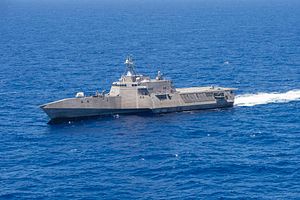On August 29, the Independence-class Littoral Combat Ship (LCS) USS Coronado has suffered an engineering casualty en route to Singapore during a deployment with the U.S. Navy’s Seventh Fleet in the Western Pacific, USNI News reports.
According to a U.S. Navy statement provided to USNI News, as a result of the engineering casualty “the crew took precautionary measures and the ship is currently returning to Pearl Harbor to determine the extent of the problem and conduct repairs. Coronado is operating under its own power and is being escorted by USNS Henry J. Kaiser.”
It is unclear when the USS Coronado will resume its deployment. “The extent of repairs and any operational impact is unknown at this time. An assessment of the casualty will be completed upon return to Pearl Harbor and additional details will be made available when possible,” the U.S. Navy states.
This marks the fourth time that a LCS suffered a major incident over the last 12 months. The U.S. Navy revealed on August 28 that the lead ship of the Freedom-class LCS variant, the USS Freedom, is sidelined in San Diego after sustaining damage in one of its two main propulsion diesel engines on July 11—most likely due to a crew error.
The Freedom-class LCS USS Forth Worth is at the moment also out of action after suffering damage to its propulsion system caused by a human error in January. The ship is currently in transit from Singapore (where it languished for seven months) to San Diego for major repairs. As a result of the operating error at the beginning of the year, the captain of the USS Fort Worth was relieved of duty. The ship was the second LCS ever to be deployed to the Asia-Pacific region.
Furthermore, in December 2015, the Freedom-class USS Milwaukee sustained a combining gear casualty about 64 kilometers (40 miles) off the Virginia coast during an Atlantic transit. The problem was traced back to a software issue, which caused a clutch not to disengage when the ship was switching engines, and not human error. Lockheed Martin fixed the issue by installing new software patches. The ship returned to active duty in June.
The most recent casualty, the USS Coronado, participated in this year’s Rim of the Pacific naval exercise, using the ship’s General Electric LM 2500 gas turbines rather than its MTU main propulsion diesel engines.
During the naval drill, the ship conducted a live fire test of a Harpoon Block 1C missile aboard the vessel with mixed results (See: “RIMPAC 2016: US Navy Test-Fires Anti-Ship Missile From Littoral Combat Ship”). It is also the first LCS to be armed with an advanced anti-ship missile. As I reported previously, the ship is currently being fitted with a RGM-84D Harpoon Block 1C missile system in Pearl Harbor, Hawaii.
The engineering casualty on the USS Coronado “appears to be unrelated to recent propulsion problems on Freedom and Fort Worth,” according to a U.S. Navy statement. The commander of U.S. Naval Surface Forces, Vice Admiral Tom Rowden said in a statement that there is a need for “improvements in engineering oversight and training.”
“The recently completed LCS Review of manning, design, and training looked at a number of sailor performance and ownership factors, to include crew rotation, size and proficiency,” he said. “From this work, I believe we will be able to make immediate changes to help reduce chance for future operator error. I am fully committed to ensuring that our ships and the Sailors who man them have the proper tools and training they need to safely and effectively operate these ships.”
The LCS review was ordered by Chief of Naval Operations Admiral John Richardson in early 2016.






























